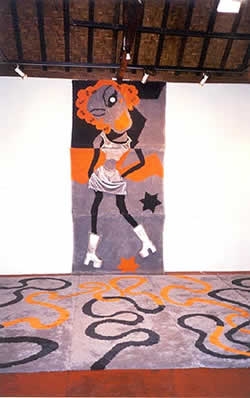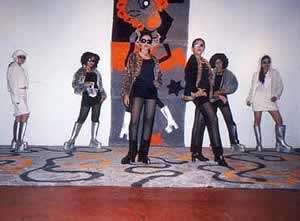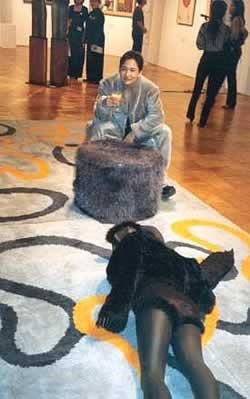Feature: Reviews
Tiara Dame Ruth Sirait: Sweet Lolly
- Kedai Kebun Gallery
- Yogyakarta Indonesia
- July 5 - 30, 2001
When I told people that I was going to be traveling in Indonesia for five weeks this summer, the response rarely deviated from two thoughts of mind. Those a bit familiar with the country through the occasional news report would ask, “Aren’t they having some sort political problems there?” (To which the answer is an emphatic “yes.”)
The second sort of reply I heard came from those who had visited the country (Lonely Planet guide in hand) and offered “the shadow puppets, Ramayana Ballet, and Gamelan are amazing.” However, when I’d mention that I was actually more interested in Indonesia’s contemporary alternative art scene and perhaps the influence that the country’s political tension has had on the work being made there, the unanimous response was “Do they have an alternative art scene?” I wondered the same since I couldn’t recall ever having seen or read anything about contemporary art in Indonesia, but I was determined to find out.
I flipped through my ten-year-old collections of Artforum, ArtNews, and Art in America, scouring both features and the review sections for a headline reading “Indonesia,” which proved to be fruitless. Research on the Web produced an academic history of Indonesian art over the last 30 years — one that reflected interests and trends throughout the art world during the same period (a rejection of modernism in the ‘70s, a booming market in the ‘80s, and a heavily post-modern approach in the ‘90s). I also found several essays specific to Indonesian concerns, mainly the struggle between embracing and rejecting Western influence on their contemporary art. However, nothing I came across gave me a sense of what is happening NOW.
As is often the case, my best source came from a ‘friend-of-a-friend’ who had lived in Indonesia and as luck would have it, is a contributing writer to Latitudes Magazine, the best resource for contemporary culture in Indonesia. Through Dan’s connections, I was able to find a thriving alternative arts community in Yogyakarta (pronounced Jojakarta) on the island of Java.
“If you are going to Yogya your first top should be the Cemeti gallery on Jl. Parankritis. These folks are the foundation of contemporary and media art in Yogya.” This was what I wanted to hear. So following Dan’s suggestion, I stopped in at the Cemeti, where I was welcomed with ginger candy and an invitation to sit down and hear about the city’s contemporary arts community. Program Directors Alsyah Hilal and Sudgud Dartanto presented me with several binders of slides from their past exhibitions and I was struck by how similar the art in Yogyakarta was to work being created in San Francisco, yet with a clear identity of its own. In addition, Hilal and Dartanto gave me a list of alternative spaces I should check out.
As I walked into the Kedai Kebun Gallery to see Tiarma Dame Ruth Sirait’s installation, Sweet Lolly, I had no idea what to expect from a show with that title by a young Indonesian artist and fashion designer, in a third-world city known for batik.
Created from remnants of fine gray, orange, and black shag carpet and installed in three attached sections on the central wall from floor to ceiling, a winkin’, feisty femme with curlers in her fiery coif and hand on hip stares out at viewers, coquettishly daring them to mess with her. Her stylish silver stretch midriff-baring tank and mini-skirt are actual clothes and have been attached to the surface of the rug, as have her silver platform moon boots that point playfully inward at each other. In front of this devilish diva, an area rug of the same gray shag sprawls across the orange cement floor with serpentine scrawls of black and orange running through it and bringing to mind a ‘70s favorite — the game Snakes and Ladders. In one corner of the gallery fur jackets made from pelts of leopard, mink, sable, and rabbit hang from a fake fur-covered clothes rack and look like the coat check of a Long Island country club. In the opposite corner a black mannequin stands on a patch of black fur, draped in a short coat of the same fleece and sports a fashionable bonnet that could only be described as Barbarella meets Bambi with its sweetly cocked silver-lined fur ears.
The gallery is also openly connected to a restaurant that becomes part of the installation through its orange and black fur covered tables and chairs. Everything has a price tag attached to it with the logo for Poleng Studio, Sirait’s fashion design company (Poleng is a Balinese cloth that’s black and white and used mostly in traditional ceremonies to signify the philosophy of balance of dark and light, day and night, earth and sky.) A table in the gallery offers photographs taken at the opening, a vogue event filled with vampy vixens struttin’ their stuff in Poleng designs of fur and furor.
I was delighted to see the blurring of fashion and art, and delivered with such playful prance. Yet, I felt dazed and confused after taking this all in - where was I? On the set of a Target commercial? And what was this about? Just fashion, fun and foreign influence? Something was amiss.
And then it hit me. It was all that fur, that oppressive fur in 85 to 95 degree year-round weather. Following this little epiphany, I read Sirait’s statement for the show:
“My home is adorned with a fur carpet. fur chairs, a fur table and every trinket’s covered with fur everywhere … sometimes it feels warm, exclusive, sensuous, ticklish, but more often than not, it feels hot and sticky and cramped and boring and just searing hot!
Even though it has sweet colors, enticing and inviting people to enjoy its beauty … this suffocating homogeneity brings a cruel hypocrisy … everything seems the same on this surface as it is the surface indeed that is the only comprehensible reality now.”
I considered the environment and climate described by Sirait—the beauty and intrigue contrasted by the cruelty and boredom. I also thought about the observations that I had been making during my travels and the contradictions between what I was learning from the artists I had met and the image of Indonesia presented and reinforced through commercial interests. Then I looked again at Sirait’s cheeky work and could see that it was about fashion, fun and foreign influence … yet with a bitter, sweet twist.
Tourism accounts for one third of Indonesia’s economy. The effect is striking— shop after shop filled with traditional hand-crafted works thatonce held cultural significance beyond a price tag; temples littered withcandy wrappers and cigarettes; and cremation ceremonies that seem morelike press conferences with the intrusive presence of still and videocameras on the arms of three-quarters of the attendees. The foreign impacthas also not been lost on the nation’s cultural image. While visitorsstockpile as much of the culture as they can - sarongs, scarves, instruments,carvings, music, photographs etc.—to take back home, Indonesians are expected to remain in the picture-perfect postcard image of island ambiance.Additionally, tourist demands and currency for traditional arts such asthe gamelan, batik, and Legong dance have helped to create an artisticallystagnant identity for Indonesia.
Tiarma Dame Ruth Sirait is one of the artistsshaking that image up. Through its conceptual approach to pop culture,high fashion and design, Sweet Lolly examines the foreign impacton Indonesia’s cultural landscape and offers an inspiring look at thefresh work being created there in response — turning up the heatfor both the country and the contemporary art world.
Tiara Dame Ruth Sirait: Sweet Lolly, Installation and Fashion Performance was on view July 5 - 30, 2001, Kedai Kebun GalleryJl. Tirodipuran no. 3, Yogyakarta, 376-114 Yogyakarta Indonesia




